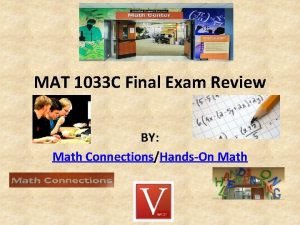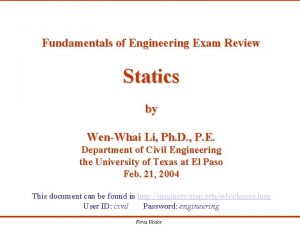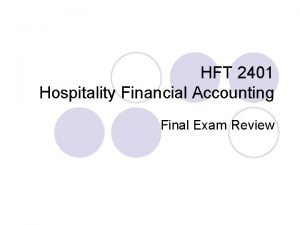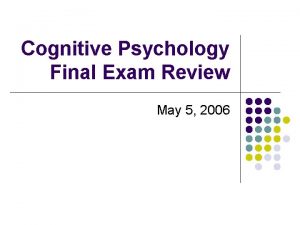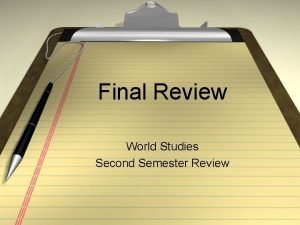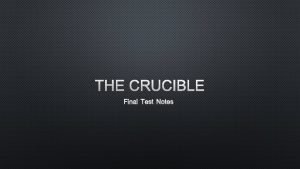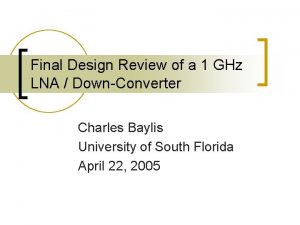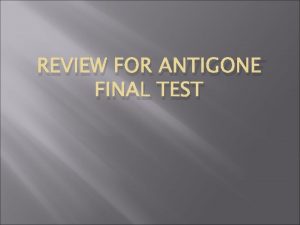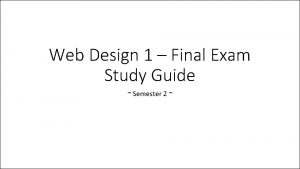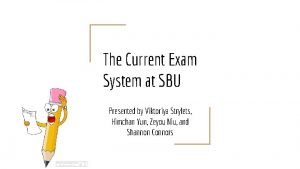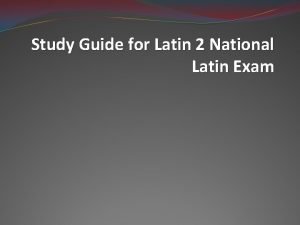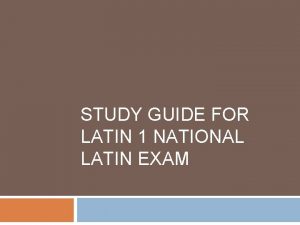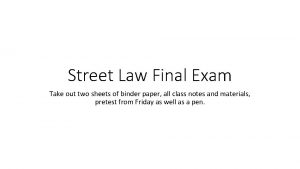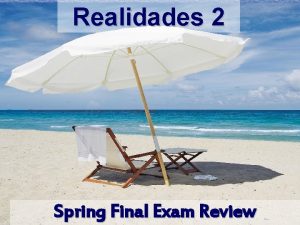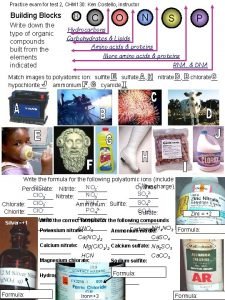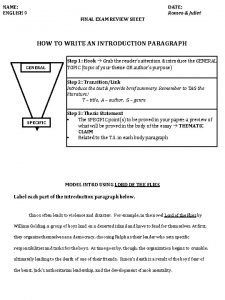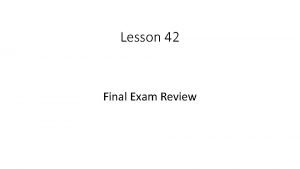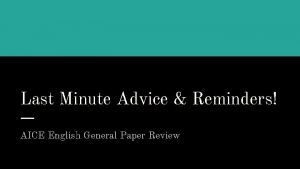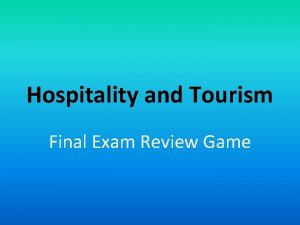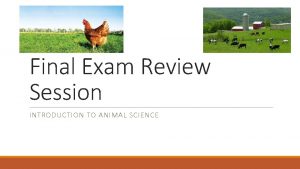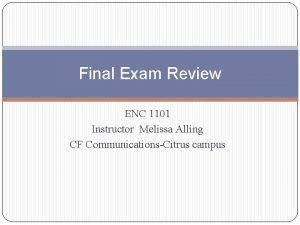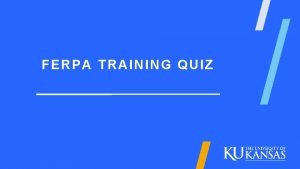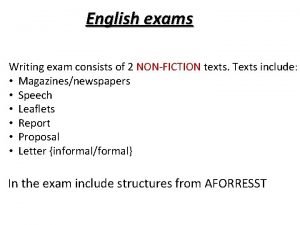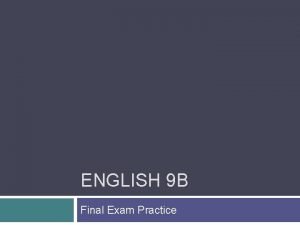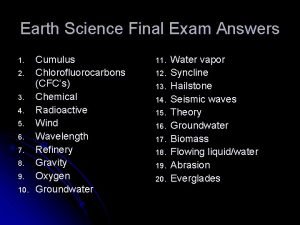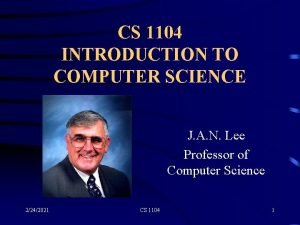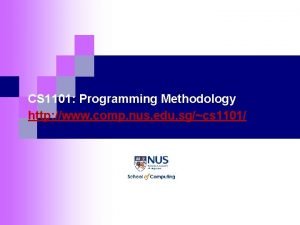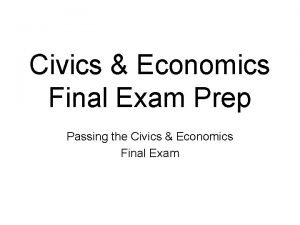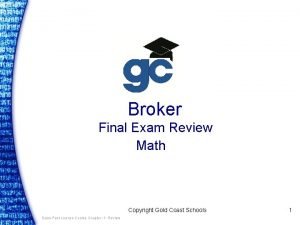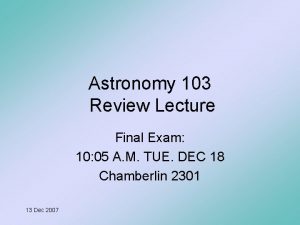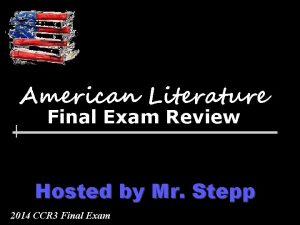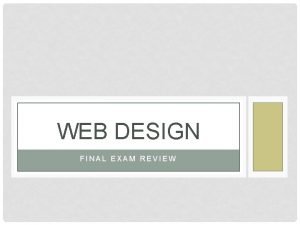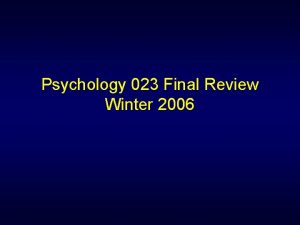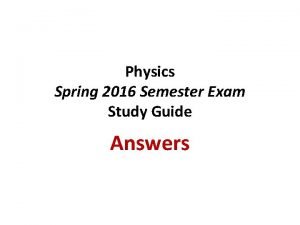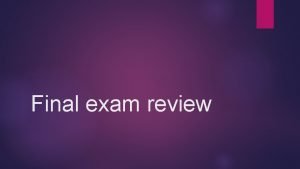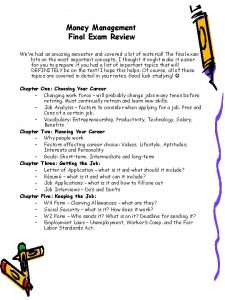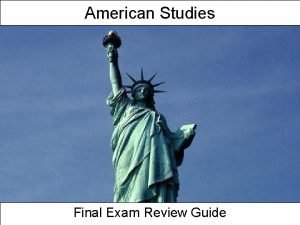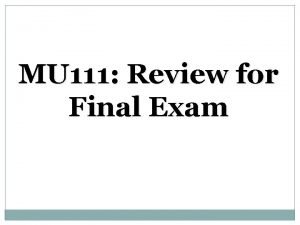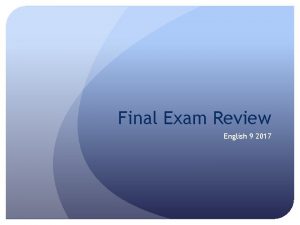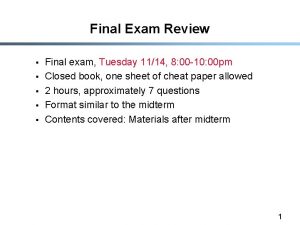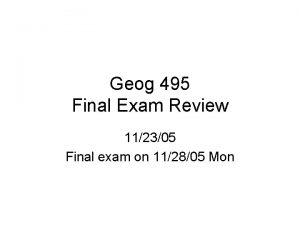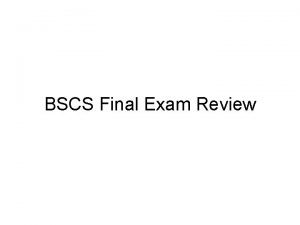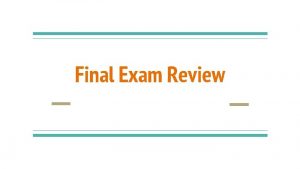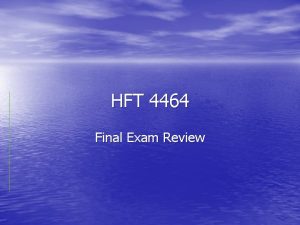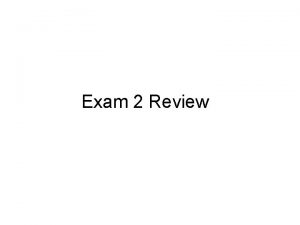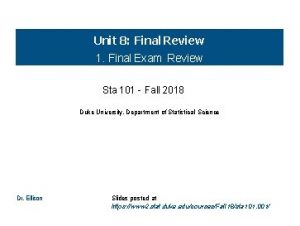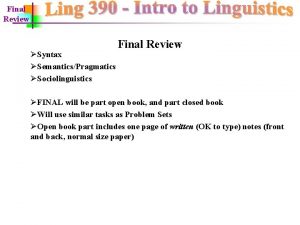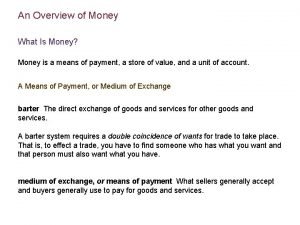MONEY MANAGEMENT II FINAL EXAM REVIEW FINAL EXAM








































































- Slides: 72

MONEY MANAGEMENT II FINAL EXAM REVIEW

FINAL EXAM REVIEW _________ is an arrangement to receive cash, goods, or services now and pay for them in the future. CREDIT When credit is used for personal needs it is referred to as _____. CONSUMER CREDIT

FINAL EXAM REVIEW An entity that lends money is called an ________. CREDITOR List two great reasons to use credit Save money Purchase items that we cannot afford on a cash basis

FINAL EXAM REVIEW What are three factors to consider before using credit? Is there a down payment? Do you want to use savings instead of credit? Can you afford the item? Could you use the credit in a better way? Can you put off buying the item for a while? What are the opportunity costs of postponing the purchase? What are the costs of using credit?

FINAL EXAM REVIEW What are three advantages to using credit? Allows you to enjoy goods and services now and pay for them later. Safer than cash Easy to track spending Rewards and perks etc…

FINAL EXAM REVIEW A one time loan that will be paid back over a specified period of time, in payments of equal amounts. CLOSED END CREDIT List some examples of items that are usually purchased with closed-end credit: HOUSES, VEHICLES, FURNITURE

FINAL EXAM REVIEW Used for the purchase of merchandise, typically requires a down payment with remaining balance of loan being paid in installments. INSTALLMENT CREDIT A loan that must be paid in full, by a specified day, typically within 30 -90 days. SINGLE LUMP-SUM CREDIT

FINAL EXAM REVIEW Credit as a loan with a certain limit on the amount of money you can borrow for a variety of goods and services. OPEN END CREDIT Examples of Open-End Credit: VISA, MASTERCARD, AMERICAN EXPRESS

FINAL EXAM REVIEW After your application for credit is approved, you typically can begin to make purchases as long as you do not exceed the LINE OF CREDIT Payment amounts, dates, applicable charges, and all other pertinent information regarding your account will be determined by the TERMS OF AGREEMENT

FINAL EXAM REVIEW Name two sources of commercial credit: Commercial Bank Credit Union Retail Stores etc… True or False: The average credit cardholder has more than six cards. TRUE

FINAL EXAM REVIEW Many credit card companies offer a _________, a time period during which no finance charges will be added to your account. GRACE PERIOD The total dollar amount you pay to use credit. FINANCE CHARGE

FINAL EXAM REVIEW True or False: Generally, if the balance is paid in full prior to the due date, there will be no finance charge to pay. TRUE How are debit cards different than credit cards? Debit cards utilize cash in your checking account. Credit cards utilize borrowed money!

FINAL EXAM REVIEW Method by which most credit cards calculate the finance charges for the period. It is found by adding each day’s balance and then dividing the total number of days in a billing cycle. AVERAGE DAILY BALANCE The cost of credit on a yearly basis. It is expressed as a percentage. ANNUAL PERCENTAGE RATE (APR)

FINAL EXAM REVIEW The process of moving unpaid credit card debt from one issuer to another. Often comes with a fee of some form. BALANCE TRANSFER A charge by the lender for using the credit card to obtain cash. Can be a flat rate or percentage (2%/$10). CASH ADVANCE FEE

FINAL EXAM REVIEW The minimum amount a cardholder can pay to keep the account from going into default. MINIMUM PAYMENT When a potential customer has passed a preliminary credit-information screening. Does not guarantee a line of credit. PRE-APPROVED

FINAL EXAM REVIEW What are some ways you can apply for a credit card? In person, at a financial institution In person, through a promotional event like a sporting event or welcome week on a college campus By telephone Traditional mail Online

FINAL EXAM REVIEW Outline of all of the specifics of your relationship with the creditor. TERMS AND CONDITIONS What are three things that you could find in your terms and conditions? Finance charges Due dates Specific lending policies Much, much more!

FINAL EXAM REVIEW What are the 5 C’s: CHARACTER, CAPACITY, CAPITAL, COLLATERAL AND CONDITIONS. Which “C” attempts to measure what type of person you are when it comes to paying your bills? CHARACTER

FINAL EXAM REVIEW How can creditors try to measure your character? References (Both personal and professional) Criminal background check Have you used credit before? How long have you lived at your current address? How long have you held your current job?

FINAL EXAM REVIEW What “C” attempts to measure how much debt you can take on? CAPACITY What questions can a creditor ask to try to assess your capacity? What is your job and how much is your salary? Do you have other sources of income? What are your current debts?

FINAL EXAM REVIEW A common ratio used to calculate capacity: DEBT PAYMENTS-TO-INCOME RATIO This ratio is calculated as follows: Total Monthly Debt (not inc. housing) Monthly Net Income It is highly recommended to keep this ratio under ? ? ? 20%

FINAL EXAM REVIEW Stuart just received his first job offer after graduating from beauty school. His expected monthly income is $2, 500. The only debt payments he has are school loan payments of $375 a month. What is his Debt Paymentsto-Income Ratio? Debt Payments ÷ Monthly Net Income $375 ÷ $2, 500 =. 15 15%

FINAL EXAM REVIEW Any item of value that you own ASSET Examples of Assets Cash Property Personal possessions Investments

FINAL EXAM REVIEW Which “C” is represented by taking the total value of your assets and subtracting your total debt? CAPITAL Why do creditors care about how much capital you have? Capital tells them if you have other ways to pay back your debt besides new income.

FINAL EXAM REVIEW Which “C” is something pledged as a security for repayment of a loan. COLLATERAL Which “C” refers to both big and small picture concerns outside of just you. CONDITIONS

FINAL EXAM REVIEW What types of things to lenders look at when assessing conditions? General economic conditions at the time of applying? Unemployment Rate Recession your specific company and position. Is your position in demand? How expendable are you?

FINAL EXAM REVIEW What are some tips or applying for credit if you don’t have much of a credit history (Young borrower or bad history) Establish a checking or savings account Borrow against your savings account Open a department store credit card Gas Cards! Get a Cosigner

FINAL EXAM REVIEW The record of your complete credit history CREDIT REPORT Credit reports are collected and maintained by CREDIT BUREAUS

FINAL EXAM REVIEW The three major credit bureaus are: Experian Trans Union Equifax How do credit bureaus make money? By selling the information they collect to creditors who are considering extending loans/credit.

FINAL EXAM REVIEW Where do credit bureaus get their information from? Banks, stores, other types of finance companies and lenders, courts and other public records The information they collect includes: Type of credit they have extended The amounts and terms of the loans Customer’s paying habits

FINAL EXAM REVIEW A typical credit report includes what type of information? Name Address Social Security Number Employment Info (Where, Position & $$) Homeowner or Renter Status Checks returned for insufficient funds Your spouse’s information

FINAL EXAM REVIEW TRUE OR FALSE: Credit reports also contain very detailed information on EVERY loan or use of credit. TRUE These reports are updated regularly to show: Payments you have made (Both amounts and number of) Late Payments Missed Payments How much you still owe Lawsuits & judgments against you

FINAL EXAM REVIEW To ensure citizens rights were being protected, Congress passed the ________ FAIR CREDIT REPORTING ACT The act regulates the use of credit reports by: Deleting out of date information Giving consumers access to their reports Giving consumers the right to correct discrepancies Limiting who can obtain your credit report

FINAL EXAM REVIEW The majority of information in your report may only be reported for how long? 7 years If you have declared personal bankruptcy this time frame becomes. . 10 years Credit Bureaus can disclose information past these time frames if: A credit application of $75, 000 or more Apply for life insurance of $150, 000 or more

FINAL EXAM REVIEW A measure of a person’s ability and willingness to make credit payments on time. CREDIT SCORE Most commonly used credit score FICO SCORE How is your FICO score calculated? It’s a secret BUT it includes Payment History, Current Debt, Length of Credit History, Types of Credit Accounts and Attempts at New Credit

FINAL EXAM REVIEW Why is a good credit score important? Determines whether or not your improved High score means lower interest rates Low scores mean higher rates and fees Insurance rates are affected by credit scores too! What can you do to improve your credit score? Make payments on time! Reduce overall debt Review your credit report for errors Limit your applications/inquiries

FINAL EXAM REVIEW When there is some form of error in billing to your credit account. BILLING ERROR Some examples of billing errors: A charge for something you did not buy An amount on your bill that is different from the actual amount you paid Arithmetic errors “Double” billing Payments not credited to your account

FINAL EXAM REVIEW Using someone’s name, Social Security Number, credit card number, or personal information, without consent, for your own purposes. IDENTITY THEFT Signs of Identity Theft include: You see withdrawals from your bank account that you can’t explain. You don’t get your bills or other mail. Debt collectors call you about debts that aren’t yours. You find unfamiliar accounts or charges on your credit report. Medical providers bill you for services you didn’t use.

FINAL EXAM REVIEW What are a few steps you can take to try to prevent identify theft? Keep financial documents locked away Ask “Why” when probed for personal information Shred personal documents when no longer needed Watch your mail! Be clever with passwords Get good encryption and antivirus software REVIEW YOUR CREDIT INFORMATION REGULARLY!

FINAL EXAM REVIEW A ________ begins with an unpaid bill…. DEBT COLLECTION The companies who purchase this debt is called a DEBT COLLECTION AGENCY

FINAL EXAM REVIEW Debt collection agencies must adhere to protocols established by the: FAIR DEBT COLLECTION PRACTICES ACT List two protections provided by the Fair Debt Collection Practices Act: Can’t call before 8 AM or after 9 PM Can’t Curse or insult you Can’t demand that you pay more than you owe Can’t claim papers they send you are legal forms if they are not Make up consequences for not paying your debt Can’t call you at work if your employer does not allow it

FINAL EXAM REVIEW TRUE or FALSE: All financial counseling programs are non-profit. FALSE. Beware! Not all financial counselors are built the same! Many companies in this industry exist purely for profit. The legal process in which some or all of the assets of a debtor are distributed among the creditors because the debtor is unable to pay their debt. BANKRUPTCY

FINAL EXAM REVIEW The chance of loss from an event that cannot be entirely controlled. RISK Transfers risk from an individual to an insurance organization. INSURANCE A contract that specifies what risks are covered and how much will be paid for losses. POLICY

FINAL EXAM REVIEW Money paid each month to purchase the insurance policy. PREMIUM Amount of money paid out of pocket by policyholder before the insurance coverage begins DEDUCTIBLE Amount of money, after deductible, that is paid jointly by the insured and the insurance company CO-INSURANCE

FINAL EXAM REVIEW In most cases, people acquire insurance from a variety of sources. What are some? VIA EMPLOYER'S, PURCHASE INDIVDUALLY THROUGH INSURANCE COMPANIES, GOVERNMENT You have a baby and need medical care. What covers the risk? HEALTH INSURANCE You get injured and can't work for six months. You need help covering your expenses. What covers the risk? DISABILITY INSURANCE

FINAL EXAM REVIEW Your home is destroyed by a tornado. What covers the risk? Homeowner's Insurance (Property) You get in a car accident and injure somebody else. What covers the risk? Automobile Insurance (Liability) The sudden death of a family member results in a loss of income that creates a financial hardship. What covers the risk? Life Insurance

FINAL EXAM REVIEW KNOW HOW TO DO INSURANCE CALCULATIONS! STEP ONE: Determine the total cost incurred from the event. Example: Fire damage to your home costs $30, 000 worth of damage. STEP TWO: Know your deductible. Subtract this from the total cost. Example: Your property insurance has a deductible of $1, 000 for all claims

FINAL EXAM REVIEW KNOW HOW TO DO INSURANCE CALCULATIONS! STEP THREE: Determine if your policy includes coinsurance. If so, what percentage are you responsible for? Example: Your insurance does involve coinsurance, requiring you to pay 15% of any costs of the claim, after the deductible. STEP FOUR: Add deductible and any co-insurance payments to determine total cost to policyholder.

FINAL EXAM REVIEW Example Overview: Your house incurred damage from a fire accident, resulting in $30, 000 worth of repairs needed. You are responsible for a $1, 000 deductible and 15% of all costs after the deductible. $30, 000 - $1, 000 = $29, 000 15% of $29, 000 (29, 000 X. 15) = $4, 350 $1, 000 + $4, 350 = $5, 350 total cost to policyholder $5, 350 sure is a lot of money but it sure is cheaper and easier to recover from than $30, 000 worth of debt!

FINAL EXAM REVIEW Know the Risk Management Strategies: I’m not going to do it. Ex: Not driving as to avoid traffic accidents. This is an example of: RISK AVOIDANCE I’ll do/won’t do this to lower my risk. Ex: Not smoking to reduce chances of cancer. RISK REDUCTION I understand there’s a risk, but I got this. Ex: Not using comprehensive coverage on an old car. RISK ASSUMPTION

FINAL EXAM REVIEW Transfer the risk to somebody else. Ex: Purchase insurance policies. RISK SHIFTING Anything that may possibly cause a loss. Examples are fire, windstorms, robbery. PERIL Failure to take ordinary or reasonable care to prevent accidents from happening. Ex: Not clearing ice from front steps. NEGLIGENCE

FINAL EXAM REVIEW The 5 basic areas of coverage offered by homeowners insurance are: Building & Other Structures – house, garage, sheds Additional Living Expenses – living expenses if home is damaged and needs to be repaired. Personal Property – covers personal possessions against loss from theft or damage Liability – protection for other people getting hurt on your property. Specialized Events – Special events that may not be typically covered. For example, flood and earthquake coverage

FINAL EXAM REVIEW Four types of Auto Insurance Coverage: Liability Insurance – coverage for other people or their property Medical Payment Insurance – medical payments for driver and passengers Uninsured/Underinsured Motorists Insurance – covers injury or damages caused by an uninsured or underinsured driver. Physical Damage Insurance Comprehensive – theft, damage from storms, vandalism etc. . Collision – car crashes

FINAL EXAM REVIEW What are some factors that influence car insurance prices: Age Gender Marital Status Driving Record Type and age of vehicle Vehicle Use Place of residence Number of drivers on the policy

FINAL EXAM REVIEW Why is insurance important? Provides Peace of Mind (Before) & Financial Security (After) Typical in many health insurance plans. It sets dollar limits that a policyholder must pay out of pocket for select services. Not a part of every insurance plan. Co-Pays … For example: $15 for an office visit

FINAL EXAM REVIEW A stated sum of money payable upon the death of the insured is called a: DEATH BENEFIT The person named to receive the benefits from an insurance policy. BENEFICIARY What are some ways life insurance is used? TO PAY OFF A MORTGAGE, REPLACE LOST INCOME, EDUCATION FOR CHILDREN, RETIREMENT SAVINGS ETC. .

FINAL EXAM REVIEW What is the test for whether or not you need life insurance? Generally, if your death would cause financial HARDSHIP, or suffering, for somebody, then life insurance is a wise purchase! Households with children, generally, have the greatest need for life insurance. Although ANYBODY can have people that depend on them for support! Single people who live alone (or with their parents) usually have little or no need for life insurance unless they have a great deal of debt or want to provide for their parents, a friend, other relatives, or a charity. Oftentimes, having a small policy just to cover funeral expenses is enough.

FINAL EXAM REVIEW Insurance that provides protection against loss of life for only a specified term, or period of time. TERM LIFE A permanent life insurance policy for which you pay a specified premium each year for the rest of your life. Coverage doesn’t end. WHOLE LIFE Which is usually cheaper … term life or whole life? TERM LIFE

FINAL EXAM REVIEW Variation of life insurance that is usually offered by employers. Covers a large group under a single policy. The employees usually do not need a medical exam to get coverage. GROUP LIFE Always study the __________, or _________, in your policy and be sure to update the necessary information as changes in your life occur. PROVISIONS OR CONDITIONS

FINAL EXAM REVIEW A document attached to an insurance policy that changes its terms by adding or excluding specified conditions or altering its benefits. A RIDER Common examples of life insurance riders are: Waiver of Premium Disability Benefit – if you become disabled the premium is waived. Accidental Death Benefit – pays twice the value of the policy if the insured is killed in an accident. Guaranteed Insurability Option – IMPORTANT to consider. Allows you to add more insurance without new medical exams!

FINAL EXAM REVIEW What is the largest personal budget expenditure for most American adults? – HOUSING – usually it is about 1/3 of a person’s income. What is the second largest personal budget expenditure for most American adults. – TRANSPORTATION (car, insurance, gas)

FINAL EXAM REVIEW What are some reasons for the housing decisions people make? – – – – Personal and financial goals Personal values, needs, and wants Amount of money available for housing costs Financial resources and readiness Credit history Real estate prices Location preference Expected length of stay in particular place

FINAL EXAM REVIEW What are the costs associated with renting an apartment, house or condo? – – Monthly rent Security deposit Utilities – electricity, water, garbage, etc. Renter’s insurance A legal contract between the tenant and the landlord, specifying the responsibilities and rights of both parties. LEASE Owner of the rental property. LANDLORD

FINAL EXAM REVIEW The person who rents the property. THE TENANT Renters are generally: People who CHOOSE not to own a home. People who CANNOT AFFORD to own a home. The cost of using someone else’s property. RENT

FINAL EXAM REVIEW An advance payment to cover anything beyond normal wear and tear on the unit. SECURITY DEPOSIT Advantages to renting are: Easy to move, less maintenance and repair work, often have nice amenities like pool, gym or tennis courts, typically cheaper than buying etc… Disadvantages to renting are: You don’t own anything so the money is just gone, you usually have less privacy and more transient neighbors, restrictions on noise levels, pets and changing the property etc…

FINAL EXAM REVIEW What are some costs involved with PURCHASING a house. – – – – Monthly mortgage payments Down payment (one time cost) Closing costs (one time cost) Utilities – electricity, water, garbage, etc. Homeowner’s insurance Real estate property taxes Maintenance

FINAL EXAM REVIEW The difference between what the house is worth and what you owe on it is called your: EQUITY What percentage of homeowner’s have to take out a mortgage? 90% Amount of money paid on the home at time of purchase Typically 10 – 20% of the purchase price of the home DOWN PAYMENT Recommended purchase price amount an individual should pay for a home 2 ½ times their annual household income

FINAL EXAM REVIEW What are some advantages of home ownership? Build equity and make money from the investment, pride of ownership, can customize to your liking, income tax advantages etc… What are some disadvantages of home ownership? Large down payment, repair and maintenance costs, equity/cash is tied up in the home, you have to pay property taxes etc…

FINAL EXAM REVIEW People are always paying for a home. It’s just a matter of whether it is for themselves or their landlord.

FINAL EXAM REVIEW Where can you buy a car? Dealership, private owner, internet What are important factors to consider when researching possible cars? MOST IMPORTANT QUESTION … can I afford it, what is in my budget and can I make the payment! Also ask: how the car will be used, what are the costs to maintain and insure the car, personal tastes, gas mileage etc…

FINAL EXAM REVIEW Vehicle price with standard equipment, no extra options BASE PRICE Includes base price, price of options installed by manufacturer, and their transportation charge MSRP (Manufacturer’s Suggested Retail Price) Dollar value given to a used vehicle based on its year and model BLUE BOOK VALUE A vehicle in and out of the repair shop with problems monthly. LEMON

FINAL EXAM REVIEW What are pros and cons to purchasing a new vehicle? – Pros: Not pre-owned, Warranty, Usually have nice Manufacturer options, Wide selection – Cons: More Expensive, heavy deprecation (Loss in the vehicle’s value due to time and use (greatest cost) What are pros and cons to purchasing a used vehicle? – Pros: Cost less to buy, Cost less to insure, Avoid rapid deprecation, Wide selection – Cons: may not have a warranty, increased likelihood of having mechanical problems
 Ap gov final review
Ap gov final review Money money money team
Money money money team World history spring final exam review answers
World history spring final exam review answers Spanish final exam review packet answer key
Spanish final exam review packet answer key Human body systems final exam
Human body systems final exam Poe practice test answer key
Poe practice test answer key Ied final exam review
Ied final exam review World history fall semester exam review
World history fall semester exam review Principles of business final exam answer key
Principles of business final exam answer key Spanish 2 final exam review answer key
Spanish 2 final exam review answer key Environmental science final study guide
Environmental science final study guide Ap world history jeopardy review game
Ap world history jeopardy review game Us history final exam semester 2
Us history final exam semester 2 English 3 semester exam
English 3 semester exam Physics fall final exam review
Physics fall final exam review Physical science jeopardy
Physical science jeopardy Mat1033c
Mat1033c Fe exam statics
Fe exam statics Zoology semester 1 exam review answers
Zoology semester 1 exam review answers Earth science final exam review
Earth science final exam review Algebra 1 final review packet
Algebra 1 final review packet Financial accounting final exam review
Financial accounting final exam review Personal finance final exam review
Personal finance final exam review Spanish 1 final review
Spanish 1 final review Psychology final exam review
Psychology final exam review Hrm question paper 2020
Hrm question paper 2020 The great gatsby setting
The great gatsby setting Money smart money match
Money smart money match Money on money multiple
Money on money multiple The great gatsby historical background
The great gatsby historical background How is daisy described in the great gatsby
How is daisy described in the great gatsby World history and geography final exam study guide
World history and geography final exam study guide World history semester 2 final review packet
World history semester 2 final review packet Geometry final exam
Geometry final exam Tolerates no challenge to his authority
Tolerates no challenge to his authority Final design review
Final design review Chemistry fall semester exam review answers
Chemistry fall semester exam review answers Apes semester 1 review
Apes semester 1 review World history semester 1 final exam study guide answers
World history semester 1 final exam study guide answers Antigone final test review
Antigone final test review Web design final exam
Web design final exam American history final exam
American history final exam Sbu final exam schedule
Sbu final exam schedule National latin exam results
National latin exam results Latin 2 final exam
Latin 2 final exam Street law final exam
Street law final exam What is the answer
What is the answer Realidades 2 final exam
Realidades 2 final exam Chm 151 final exam
Chm 151 final exam Chem 130 final exam
Chem 130 final exam Romeo and juliet final exam study guide
Romeo and juliet final exam study guide 42 final exam
42 final exam Aice english general paper
Aice english general paper Hospitality and tourism final exam
Hospitality and tourism final exam Hbs eoc study guide
Hbs eoc study guide Animal science final exam
Animal science final exam Enc 1101 final exam
Enc 1101 final exam Ferpa quiz answers penn state
Ferpa quiz answers penn state Simile in writing
Simile in writing Abc final exam practice test
Abc final exam practice test World literature in english
World literature in english Earth science final exam answers
Earth science final exam answers Cs 1104
Cs 1104 Cs 1101 programming fundamentals
Cs 1101 programming fundamentals Civics and economics final exam
Civics and economics final exam Gold coast final exam 1 answers
Gold coast final exam 1 answers Astronomy 103 final exam
Astronomy 103 final exam American literature final exam
American literature final exam Used font
Used font ____________is used to give the tab space in vb.net
____________is used to give the tab space in vb.net Gratification disorder
Gratification disorder Prayer before.exam
Prayer before.exam Physics semester 1 final exam study guide answers
Physics semester 1 final exam study guide answers
















